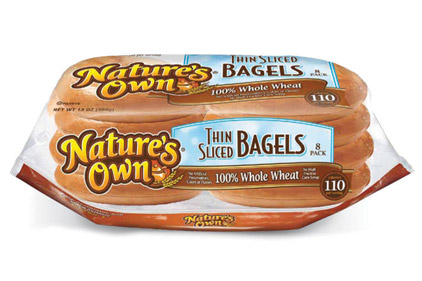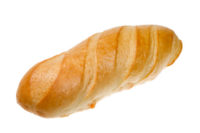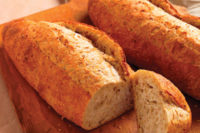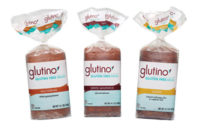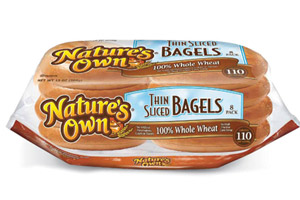 Major-league bakers are rolling with the hit of the economy, sluggish sales and soaring commodity prices and somehow see a light at the end of the tunnel oven. The economy has slugged bakery operations in the chest over the last few years because many are institutional and restaurant-based, and several restaurants and other facilities throughout the country have closed. “People are just now starting to go out to restaurants again—finally,” observes Larry Marcucci, president of Chicago-based Alpha Baking Co. “So the economy has definitely had its affect on us. We had to sell to a lot more customers to keep the same level of volume.”
Major-league bakers are rolling with the hit of the economy, sluggish sales and soaring commodity prices and somehow see a light at the end of the tunnel oven. The economy has slugged bakery operations in the chest over the last few years because many are institutional and restaurant-based, and several restaurants and other facilities throughout the country have closed. “People are just now starting to go out to restaurants again—finally,” observes Larry Marcucci, president of Chicago-based Alpha Baking Co. “So the economy has definitely had its affect on us. We had to sell to a lot more customers to keep the same level of volume.”
“One of the biggest challenges we are seeing is volatility in commodities,” admits Richard Spencer, director of new products development at Dawn Food Products, Jackson, Mich. “The degree of uncertainty is providing new hurdles for all aspects of the organization, from procurement to product development and production to sales and customer service. From a product development standpoint, we are continuing to look at innovative ways to deliver the great taste and quality that are necessary to drive consumer purchase, but still achieve the financial requirements of the organization. It’s a delicate balance that mandates honest cross-functional dialogue and a willingness to challenge sometimes long-held assumptions or beliefs about a product offering.”
Dorothy Radlicz, director of marketing at artisan bakery Chabaso Bakery in New Haven, Conn., says she believes that the more difficult economic climate may be causing a sensitivity to waste and portion control (some of which is price-point driven). “I believe this will continue to be translated into an increased interest in smaller items. At the same time, people are more inclined to treat themselves to higher quality breads, for example, then maybe some items that are perceived as not so necessary. Bread is more of a daily staple.”
Commodity costs are also a great challenge because they keep on increasing, says Alon Ozery, co-founder of Toronto-based Ozery Bakery. His company is positioned in the commercial bakery segment and also makes private-label products, as well as a recently introduced line of pre-sliced, organic ancient grain buns made of kamut, spelt and whole wheat.
But Ozery says his company is growing and increasing its baking capacity by adding more baking equipment lines to its new facility. Bakers are definitely starting to think outside the “bread box,” as consumers are very nutritionally savvy, more sophisticated and more label-conscious. Thus, new breads are being developed, and bakers are coming up with products that contain better-for-you twists, more whole grains, new inclusions, artisan styles and new shapes, including a recent plethora of rounds.
At Flowers Foods, Thomasville, Ga., the biggest challenges facing companies that compete in the bread aisle category are rising costs of commodities and fuel combined with a slow economy and tough competition in the baking category, says Janice Anderson, vice president of marketing. “This is putting a lot of pressure on wholesale bakers. Our company’s response is to remain focused on continually improving the efficiency and performance of all areas of our business so we can continue to offer baked foods of quality and value to our consumers and long-term return to our shareholders.”
Healthy, wholesome players
With the new U.S. Dietary Guidelines of Americans that went into affect beginning of this year, healthy, wholesome bread products are taking on a Most Valuable Player role in the trends of 2011. Consumers are demanding less sodium, trans-fat and cholesterol and more fiber-rich ingredients, and bakers are faced with challenges to reformulate products, create new products or eliminate others. Studies also show that shoppers tend to eat more of foods they believe are natural, so the term “natural” is being adopted more and more. “I would like the industry as a whole to commit to using less chemicals in baked goods,” says Ozery.
“Right now, the industry is still riding the whole grain trend,” Anderson reports. “Whole grain bakery foods continue to be popular with consumers as are products that offer portion-control, reduced calories or other types of healthy option, such as higher fiber. In the sweet goods category, consumers seem to be opting more for indulgent snacks, perhaps as a reward for healthy eating.”
Anderson sites data from Chicago-based SymphonyIRI Group, for the 52 weeks ending March 20, where dollar sales of total fresh packaged breads (loaf bread, rolls, bagels and English muffins) were up 0.6%. Bread products with a whole grain claim were up 5.4% over the previous year.
“The whole nutritional issue is still out there, with front-of-pack [labeling] being pushed, and there is more focus in restaurants for that information,” adds Marcucci.
“Better-for-you products will continue their ascent,” echoes Radlicz. “This is not only ingredient-driven, but freshness is also an important factor.”
Experts agree that whole grains are also a home run on the baking game field. “Eat whole grains more often,” suggests nutrition researcher Joanne Slavin of the University of Minnesota, Minneapolis. “We are finding that things in whole grains like antioxidants and lignans and various phytochemicals may help reduce the risk of heart disease and cancer.” Harvard researchers report that research participants who ate more whole grains had a lower risk of diabetes.
“When you eat whole grains, you get more fiber and more micronutrients like folic acid, magnesium and vitamin E,” says Walter Willett, chairman of the Nutrition Department at the Harvard School of Public Health, Boston.
Chabaso Bakery has been using whole grains and seeds in some of its artisan recipes for the East Coast market since it opened in the mid-1990s. Using “old-world” ovens, the best natural ingredients available and no trans-fats, founder Charles Negaro and a crew of bakers set out to match the best ciabattas, loaves, batards, rolls, baguettes and boules in the world.
“Because whole grains are proving to be so beneficial, I’m often asked why more people don’t eat them more often,” reports Radlicz. “People don’t know enough about them, where to find them or how to incorporate them into their diets in a reasonable way. We’re very familiar with old-world recipes and baking techniques using all-natural ingredients, but we succeed in business by being guided by our customers’ choices. Whole grain bread sales have grown significantly in recent years,” she explains.
“Because we trust that our customers are making smart choices, we are committed to providing a wide range of whole grain products to meet the growing demand,” she says.
The tortilla industry has witnessed strong growth in the last five years, making it one of the fastest growing segments in the baking industry. Tortillas made of whole grains are also being introduced. However, rising commodity prices and bad weather have affected corn crops this year, which has tortilla marketers concerned. Yet despite the problems, tortilla manufacturers are coping by keeping up with the latest trends in the food industry.
“The cost of commodities used in making tortillas has gone up significantly, some of it due to excessive speculation among commodity traders and some of it, particularly in the case of corn, due to non-food demands such as corn ethanol as an alternative or additive to gasoline,” attests Jim Kabbani, chief executive officer of the Tortilla Industry Association (TIA), Arlington, Va. “But meanwhile, this cost pressure has forced a number of changes on tortilla manufacturers, in particular small to mid-size companies. Unable to raise prices to the same degree as rising costs, they have sought to lower other costs through increased efficiencies, both in-plant and in business, such as optimizing distribution channels, co-packing and the movement toward larger customers.”
Still, he says, while there’s great disagreement regarding the economy overall, including the nature and extent of any economic recovery, the tortilla industry has grown from $6 billion a year a few years ago to an estimated volume of $11 billion by end of this year. “At least as big part of this grown driver has been the rapid adoption of tortilla consumption by non-Hispanic consumers,” Kabbani says.
Old school is cool
Some of the sweet goods out there such as Hostess Twinkies and CupCakes, from Hostess Brands, Irving, Texas, are harking back to earlier times, with retro packaging, the reintroduction of earlier flavors or formulations or new recipes that have an old-fashioned but memorable taste.
“Hostess set the standard for timeless treats loved form generation to generation,” says Amy Clark, director of snack marketing for Hostess. “The ‘old-school cool’ packaging and retro recipe Twinkies celebrate the brand’s amazing history and tap into the nostalgia consumers feel with every sweet bite.”
Likewise, Flowers Foods hopes to shake things up with Blue Bird and Mrs. Freshley’s treats, featuring those familiar and popular standbys—Hershey’s cocoa and chocolate chips. “Adding the great taste of Hershey’s chocolate and its strong brand recognition to delicious snack items brings something new and fun to our cake lineup,” explains Anderson. “We are also targeting the portion-controlled trend with [our] Nature’s Own sandwich rounds. This thinner version of a traditional bun has been one of the more exciting new products to hit the bakery category in recent years. It appeals to consumers who want less bread with their sandwiches. It also has a unique texture similar to flatbread.”
Sandwich rounds and thin bagels are also having a positive effect on the bakery category. “We’ve found that consumers are using them for breakfast, lunch, dinner and snacks, and are purchasing them in addition to their regular bakery items,” Anderson says. “SymphonyIRI data supports the popularity of these items. For the latest 52 weeks ending March 20, dollar sales of sandwich rounds/thins were up 45% versus the previous year, while new bagel thin products drove overall bagel segment growth.”
Flowers is also fielding a consumer request—one of its most common received, according to Anderson—for a smaller sized loaf of bread targeted at consumers in smaller households. In the fall of 2010, the company rolled out a 16-oz. Nature’s Own 100% Whole Wheat with Honey soft variety bread with 11 g. of whole grains per slice.
Pitching to a younger audience
Radlicz thinks the demographics for artisan breads are beginning to expand but are “skewing” younger fans for higher-quality products from a nutritional and freshness standpoint. “This has been the stronghold of an older population in the past,” she says. “There is a growing openness for various types of foods but also for better quality. Besides parents introducing these items more readily at home, some school systems for all age groups and preschools to colleges are beginning to execute better food offerings for the children via the food they are providing for daily consumption.”
Cindy Lawson, vice president of trade development/foodservice at Flowers Bakeries, says that while Flowers doesn’t produce true “hand-made” artisan breads, it does purchase artisan-style breads and rolls from other vendors. “Artisan breads are a niche category across retail, in-store and foodservice segments, and our research shows sales to be relatively flat, year-over-year,” she says. “But in foodservice, high-end, full-service restaurants bake artisan breads from scratch, and we believe this trend will continue. Some restaurant operators use frozen dough breads and rolls that are proofed and baked in-house, producing artisan-style products. However, as the foodservice industry continues to contract because of the economy, more restaurants may move way from frozen doughs to reduce costs.”
Over the years, gluten-free products have substantially improved in taste, with bakers pitching new products that now deliver richer flavors, honey, ancient grains, sorghum and other taste-enhancing ingredients, as well a springier texture and a stronger nutritional profile. Lower-sodium product offerings are developed to have all of the flavor, quality and taste consumers still want. Single-serve and portion-controlled baked goods are allowing consumers to enjoy and indulge, but to a lesser degree.
“We continue to see interest in pretzel roll-type products,” affirms Marcucci, who has noticed several bakeries making new pretzel roll products. “They are also showing up more often in retail now. But flatbreads are still a big trend, and anything in the reduced-calorie or good-for-you variety bread line is still doing well.”
Marcucci also notices that the surge in the artisan category seems to be coming from the chain restaurants that want different but consistent offerings that can be frozen and shipped nationwide.
New at Alpha Baking is a just-installed low-stress production line, Marcucci points out. “We’re just beginning to understand its capabilities. It will allow us to make product at [higher] speeds, as well as produce a greater diversity of products than we could before. We also set it up so do a variety of toppings because so many customers today are looking for that point of differentiation.”
The private-label pickoff
Perhaps because of the economic slump, many private-label products continue to gain strength, Marcucci adds. “Some brands produce private-label products to enhance their position in the stores. Many private-label bakeries have closed up because the owners have found better quality and more innovation from branded companies that do private-label products.
“Private label is strong in times of economic stress, and we sure are seeing that in the marketplace right now,” says Radlicz. “This, of course, is driven by people’s frugality, but these days they still expect good quality. Contrary to what might seem instinctive, as long as intelligence is used in product selection, coupling branded and private-label serve to raise the market, not to cannibalize it. We have found that the combinations of private label and branded strategy are indeed very complimentary.”
The role of private label in the category has really grown in the past few years, evolving from offering generic “me-too” versions of successful branded offerings to helping embody and reinforce the attributes and personality of a retailer’s brand itself, reports Jennifer Gardner, brand manager at Dawn Food Products. “To successfully compete, manufacturers of traditional branded offerings have to innovate—not just in the arena of product development, but also in how they interact with and respond to a customer’s needs and direction.”
Those choosing the in-store bakery (ISB) over the bread aisle are in search of freshness and quality, she adds. “The most popular items are those that are generally consumed quickly while they are fresh. Consumers are looking for more ‘indulgent’ (sweets) as well as healthier products in the ISB. Those that cater to the local population are finding good traction also.”
“Store brands continue to be an important category to our retail customers and to a segment of consumers,” add Anderson. “Overall, however, store brand breads, buns and rolls are declining as a category.”
So what gives a product or a brand staying power? Today more than ever, authenticity of brands and core values are key. “We stick to bakery basics with whole grains,” says Negaro. “Sometimes it doesn’t take a drastic change or a rigorous regimen to make a positive difference.” Chabaso bakers hand-mix whole grains and other wholesome ingredients, taking the time to make bread the old-fashioned way.
“We have both streamlined and expanded our operation to meet the demands of the marketplace,” Radlicz explains. “Expansion has occurred in the bakery operation as well as in management, and we anticipate that will continue.”
She would like to see the industry get even more inventive. “Because of my personal background as a first-generation American of parents who cook almost everything from scratch and my educational background in food and nutrition, I’d like the industry to get even more innovative as well as health-oriented.”
Bakeries are aware of the quality and authenticity mantras, Negaro attests, yet they must be careful to try not to be everything to everyone. And that’s difficult, Marcucci says, because it’s one of the biggest challenges facing companies that compete in the bread aisle. “Everyone wants something different, and it makes it tough to produce all of these things efficiently.”
Anderson says that Flowers always looks for ways to do things better—to increase efficiencies by improving processes. “We do this by opening new bakeries, adding new production lines or closing down or relocating lines, depending on what’s the best way to serve the market. Our goal is to put production where the people are. This is an operational strategy we’ve held for many years.”
The company’s most recent growth plan is to expand its direct-store-delivery territory, which currently reaches about 50% of the U.S. population. “By 2016, the goal is to expand that territory, so at least 75% of the U.S. population will have access to our fresh bakery foods through acquisitions and new bakeries.”
She adds that brands and products that pass the test of time deliver on what they promise. “When it comes to food, those promises usually involve consistent quality, taste and a fair price,” she says. “Between them, taste always takes precedence.”
Dawn Foods’ Rzeszut says he would like to change some consumers’ long-held perceptions that better-for-you options cannot taste good. “Our Weight Watchers line of sweet bakery products has attempted, and succeeded in my mind, to demonstrate to consumers that it’s possible to have a great tasting product that fits within their weight management program.”
The bread producers are thriving today and will continue to do so in the future in order to go above and beyond home plate to score a run in innovations. They get it, and listen to their audience, which is a win-win result for everyone.
